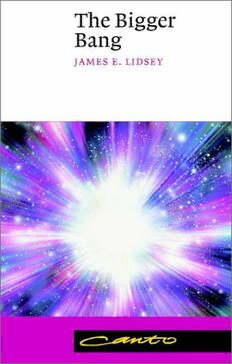
The bigger bang PDF
Preview The bigger bang
This page intentionally left blank The Bigger Bang Societies through the ages have always been fascinated with our origins. In the last few years, scientists have begun to answer some of the most fundamentalquestionsabouttheoriginandearlyevolutionoftheuniverse. This book presents a fresh, engaging and highly readable introduction to theseideas. Usingnovel,down-to-earthanalogies,authorJamesLidseysteersusdeftly onajourneytothecuttingedgeofcosmology.Step-by-step,wetravelbackin timethroughLidsey’sbookuntilwearriveattheveryoriginoftheuniverse. There we look at the fascinating ideas scientists are currently developing to explain what happened in the first billion, billion, billion, billionth of a second of the universe’s existence – the ‘inflationary’ epoch. Along the way, we are given lucid accounts of many fascinating topics in theoretical cosmology,includingthelatestideasonsuperstrings,paralleluniverses,and theultimatefateofouruniverse.Wealsodiscoverhowtheworldofthevery small(describedbythephysicsofelementaryparticles)andtheworldofthe verylarge(describedbycosmology)areinextricablylinkedbyeventswhich wovethemtogetherinthefirstfewmomentsoftheuniverse’shistory. Lucid analogies, clear and concise prose and straightforward language makethisbookadelighttoread.Itmakesaccessibletothegeneralreader someofthemostprofoundandcomplexideasabouttheoriginofouruni- versecurrentlyvexingthemindsoftheworld’sbestscientists. JamesE.LidseyisaRoyalSocietyUniversityResearchFellowatQueenMary andWestfieldCollege,UniversityofLondon.Hisresearchinterestsfocuson theveryearlyuniverse,especiallyinflationandthecosmologicalaspectsof superstringtheory.In1998,heappearedintheSundayTimes“Hot100”list ofpromisingacademics.Forrecreation,heislearningtoplaythemandolin, butwithlimitedsuccesstodate. The Bigger Bang James E. Lidsey QueenMaryandWestfieldCollege UniversityofLondon Cambridge, New York, Melbourne, Madrid, Cape Town, Singapore, São Paulo Cambridge University Press The Edinburgh Building, Cambridge , United Kingdom Published in the United States by Cambridge University Press, New York www.cambridge.org Information on this title: www.cambridge.org/9780521012737 © Cambridge University Press 2000 This book is in copyright. Subject to statutory exception and to the provision of relevant collective licensing agreements, no reproduction of any part may take place without the written permission of Cambridge University Press. First published in print format 2002 ISBN-13 978-0-511-06738-9 eBook (EBL) ISBN-10 0-511-06738-0 eBook (EBL) ISBN-13 978-0-521-01273-7 paperback ISBN-10 0-521-01273-2 paperback Cambridge University Press has no responsibility for the persistence or accuracy of s for external or third-party internet websites referred to in this book, and does not guarantee that any content on such websites is, or will remain, accurate or appropriate. Canto edition 2002 Contents Preface pagevii Acknowledgements ix 1 TheStructureoftheUniverse 1 2 WhyDoestheSunShine? 8 3 TheExpansionoftheUniverse 18 4 Space,TimeandGravity 23 5 ParticlesandForces 32 6 GrandUnification,HigherDimensionsandSuperstrings 43 7 TheBigBang 55 8 BeyondtheBigBang 66 9 TheInflatingUniverse 77 10 TheEternalUniverse 87 11 BlackHoles 96 12 TheBirthoftheUniverse 112 Index 131 v Preface We live in a big universe. Even if we were able to travel across the universe at the speed of light, the journey would take us at least ten billion years. Why is the universe so large? Has the universe always been this big, or was it smaller in the past? If smaller, how small was it?Wasthereatimewhenthevolumeoftheuniversevanished? Wecanaskrelatedquestionsregardingmatterintheuniverse.Why istheuniversenotempty?Fromwheredotheatomsthatmakeupour bodiesoriginate?Whenweretheseatomscreated? Questions such as these lead us inevitably to the origin of the uni- verse.Didtheuniversehaveadefinitebeginning,orhasitalwaysex- isted?Ifithadabeginning,canwetalkmeaningfullyaboutwhatmight havehappenedbeforehand?Andwhatcausedtheuniversetocomeinto existenceinthefirstplace? Thepurposeofthisbookistoaddressquestionssuchasthese.More- over, because our own origin is linked with that of the universe as a whole, we are indirectly studying our own past when we investigate thebeginningoftheuniverse. We will see that the structure of the universe is intimately related tothestructureofthesmallestelementaryparticles.Thisrelationship between the world of the very large and that of the very small was manifestevenduringthefirstsecondoftheuniverse’shistory.Remark- ably,theconditionsthatprevailedwhentheuniversewasnomorethan vii Preface a fraction of a second old may have led to the formation of galaxies, starsandplanets.Ourexistencebillionsofyearslaterdependsdirectly onwhathappenedatthatveryearlytime. Throughout this book we will encounter very large and very small numbers.Thestandardnotationistoexpresssuchnumbersaspowers of ten. Thus one million (1,000,000) is ten to the power six because there are six zeros that follow the 1. It is written as 106. One billion (one thousand million), then, is written as 109. We will refer to one millionmillionasonetrillionandwriteitas1012.Verysmallnumbers arewritteninasimilarway.Forexample,onemillionthisonedivided byamillionandiswrittenas10−6.Onebillionthisdenotedby10−9, andsoon. We will also encounter in this book references to a wide range of temperatures.Unlessotherwisestated,wewillmeasuretemperaturein degreesCelsius.Thelowesttemperaturepossibleis−273.16oC,which isknownasabsolutezero.Thetemperatureofouterspace,forexample, isaboutthreedegreesaboveabsolutezero. viii
